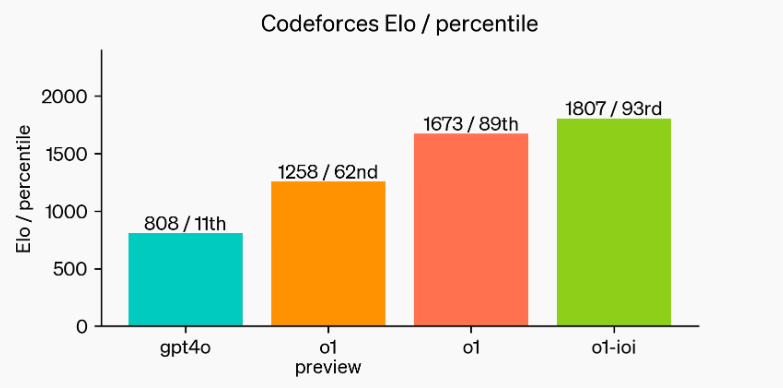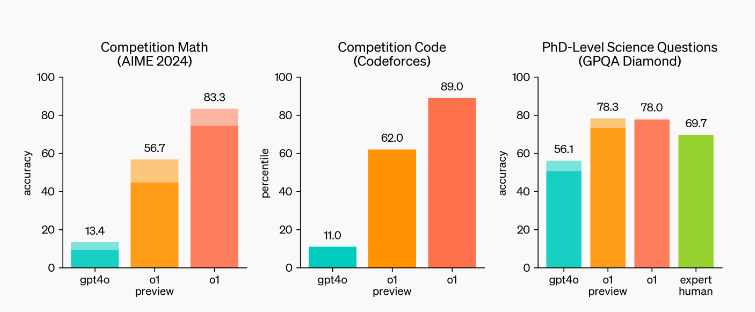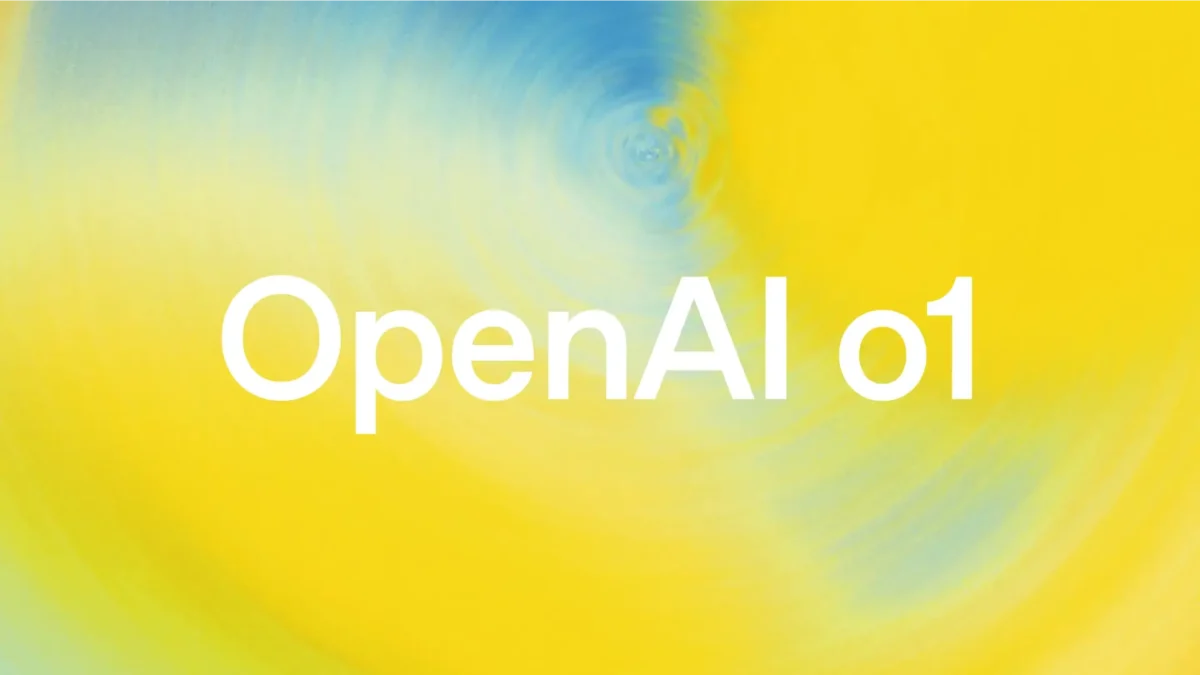Introducing OpenAI o1: The Latest AI Model Transforming AI with Human-Like Reasoning and Problem-Solving
Artificial intelligence is evolving rapidly, and with OpenAI’s new model, OpenAI o1, we are witnessing a shift in how AI approaches reasoning and problem-solving. OpenAI o1 is closely related to Project Strawberry, this model doesn’t just excel at tasks—it thinks through them, mimicking human-like cognitive processes. From complex math problems to programming challenges, OpenAI o1 pushes the boundaries of AI performance, giving us a glimpse into the future of intelligent systems.
But what makes this model so special? How does it surpass earlier models like GPT-4o in terms of performance? In this blog, we’ll dive deep into OpenAI o1’s groundbreaking capabilities and the ways it’s reshaping our understanding of AI.
A Competitive Edge: OpenAI o1 and Programming
One of the most impressive features of OpenAI o1 is its performance in competitive programming. AI has been involved in coding for a while, but with o1, we are seeing a model that ranks in the 89th percentile on Codeforces, a popular platform for competitive programming.

To put this into perspective, the model is outperforming the vast majority of human programmers, competing on par with skilled coders. But OpenAI didn’t stop there.The model was also put to the test in the 2024 International Olympiad in Informatics (IOI), one of the most challenging programming contests worldwide.
Under competition conditions, OpenAI o1 ranked in the 49th percentile against human participants. This was achieved by giving the model 50 submissions per problem, just like the human contestants. The results are a testament to the model’s refined coding skills and its ability to compete under real-world constraints.
What’s even more fascinating is how o1’s performance improves when given more freedom. When allowed 10,000 submissions per problem, it exceeded the gold medal threshold, showing that with enough time and computational power, AI could soon become a dominant force in coding competitions.
You may also like: Amazon Rufus: Revolutionizing E-Commerce with Generative AI
Mastering Math: A Leap in Reasoning Capabilities
In the realm of mathematics, OpenAI o1 has taken on challenges that were once thought too difficult for AI to handle. One such challenge is the American Invitational Math Examination (AIME), an exam designed to test the brightest high school math students in the United States.
While GPT-4o managed to solve only around 12% of the problems, o1 demonstrated impressive accuracy, solving 74% of the problems with just one attempt per question. This accuracy increased to 83% when consensus was used, and an incredible 93% with 1,000 samples and a learned scoring function. These scores put o1 among the top 500 students in the nation, a feat previously unthinkable for an AI model.

Such results aren’t just impressive—they mark a major milestone in AI’s ability to reason through highly complex and abstract problems. This leap in performance can be attributed to o1’s use of chain-of-thought reasoning, which mimics how humans break down problems step by step, refine strategies, and learn from mistakes.
Beyond Math: Excelling in Science
OpenAI’s o1 model is not only skilled in mathematics but also shows strong capabilities in scientific disciplines. The model exceeded PhD-level performance on the GPQA Diamond benchmark, which evaluates expertise in physics, chemistry, and biology. This makes it the first AI model to outperform human experts in these fields, marking a significant achievement in the development of AI capable of handling highly specialized and technical tasks.
On a range of benchmarks, including 54 out of 57 subcategories in the Massive Multitask Language Understanding (MMLU) benchmark, OpenAI o1 demonstrated its superior reasoning capabilities. In fact, the model performed so well on traditional AI benchmarks like MATH2 and GSM8K that these tests are now considered obsolete for differentiating AI models.
What does this mean for industries relying on scientific expertise? OpenAI o1’s ability to outthink human experts in specific areas could transform fields such as research, education, and healthcare. From solving complex biological problems to optimizing processes in physics, the potential applications are vast.
Chain-of-Thought Reasoning: How OpenAI o1 Learns Like Humans
At the heart of OpenAI o1’s success is its unique approach to learning and reasoning. Unlike previous models that often relied on brute force or vast amounts of data to solve problems, o1 uses chain-of-thought reasoning. This means the model thinks through each problem step by step, refining its approach as it goes—much like how a human would tackle a difficult puzzle.
Here’s where it gets interesting: through reinforcement learning, o1 learns from its mistakes, becoming better at identifying where its reasoning goes wrong and adjusting accordingly. It can try different approaches if the current strategy isn’t working, break down complex tasks into smaller, more manageable steps, and continuously improve its problem-solving techniques.
This ability to “think” through problems allows OpenAI o1 to outperform GPT-4o on reasoning-heavy tasks like math, coding, and scientific problem-solving. It’s not just about having more knowledge; it’s about knowing how to use that knowledge effectively.
The Human Factor: Preference for OpenAI o1
While AI models are often evaluated based on their ability to perform well on academic benchmarks, there’s another factor that’s just as important: how humans perceive the model’s performance. In a series of human preference evaluations, OpenAI tested how users responded to outputs from o1 versus GPT-4o. The results were clear: in categories like data analysis, math, and coding, people overwhelmingly preferred o1’s responses.
Why does this matter? In real-world applications, AI isn’t just solving problems in isolation—it’s interacting with people. Whether it’s assisting with complex data analysis, writing code, or providing scientific insights, users need to trust and feel confident in the AI’s abilities. OpenAI o1’s high preference score suggests that it delivers responses that align more closely with human intuition and expectations, making it a more reliable tool in domains requiring complex reasoning.
Safety and Alignment: A Responsible AI
As AI becomes more powerful, ensuring that it operates safely and ethically is crucial. OpenAI has integrated safety protocols into o1’s chain-of-thought reasoning, teaching the model to consider human values and principles as it solves problems. This means that o1 can reason about safety rules and apply them, making it more robust and trustworthy, even in unpredictable or novel scenarios.
Before deployment, OpenAI subjected o1 to extensive safety tests and red-teaming evaluations. The results showed that the model not only improved in terms of capability but also demonstrated enhanced safety measures, particularly in avoiding unsafe behaviors and complying with human guidelines.
The model’s safety features offer new opportunities for AI to be used responsibly, particularly in sensitive fields such as healthcare, finance, and autonomous systems, where the consequences of AI decisions can have significant real-world impacts.
What’s Next for OpenAI o1?
While OpenAI o1 has already set new standards in reasoning and problem-solving, its journey is far from over. OpenAI is continuously refining the model, making it more user-friendly and expanding its capabilities. The current version, OpenAI o1-preview, is already available to trusted API users and is integrated into ChatGPT, offering immediate access to its enhanced reasoning abilities.
In the coming months, we can expect further improvements, particularly in the areas of human-AI interaction, problem-solving across diverse domains, and perhaps most excitingly, real-world applications that harness the full potential of this next-generation AI.
Conclusion: A New Era of AI
OpenAI o1 marks a major advancement in the field of artificial intelligence. With its ability to think through problems, learn from mistakes, and outperform both previous models and human experts in specific areas, it’s setting the stage for a new era of AI that isn’t just more powerful, but more human-like in its approach to reasoning.
Whether it’s excelling in competitive programming, dominating complex mathematical exams, or surpassing PhD-level expertise in the sciences, OpenAI o1 is proving that AI can think—and think well. And with its enhanced safety protocols, we can trust that this thinking will be aligned with our values, making it a powerful and responsible tool for the future.
As we look ahead, the potential applications for OpenAI o1 are vast, and its continued development promises to reshape industries, solve complex problems, and bring AI closer to human-like reasoning than ever before.
Featured Image Source: Open AI





